
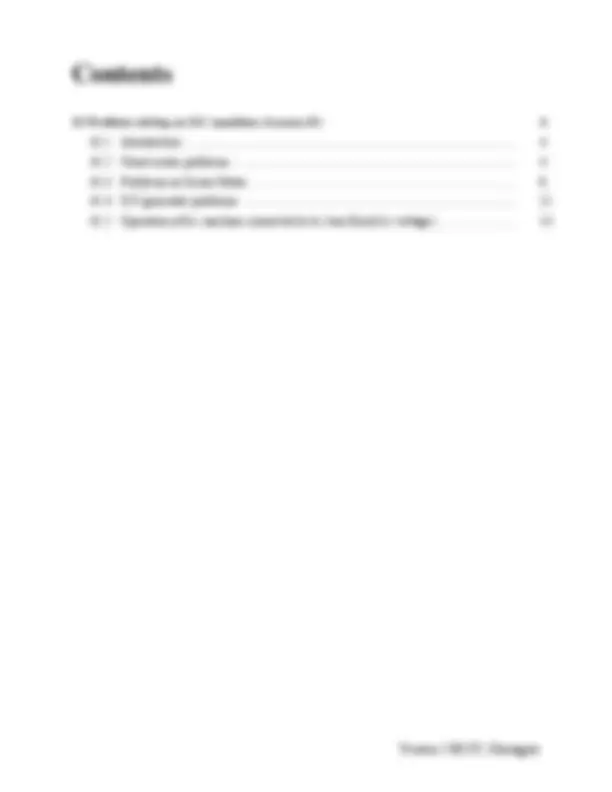
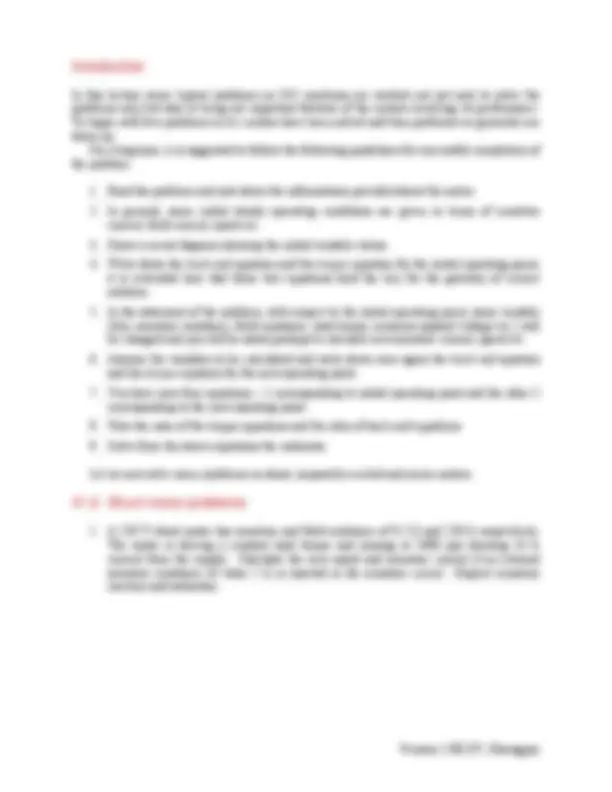
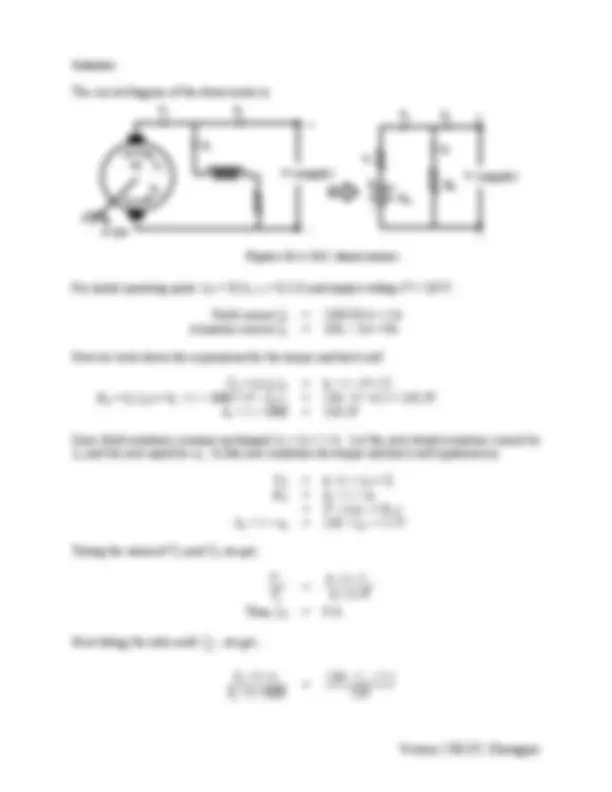
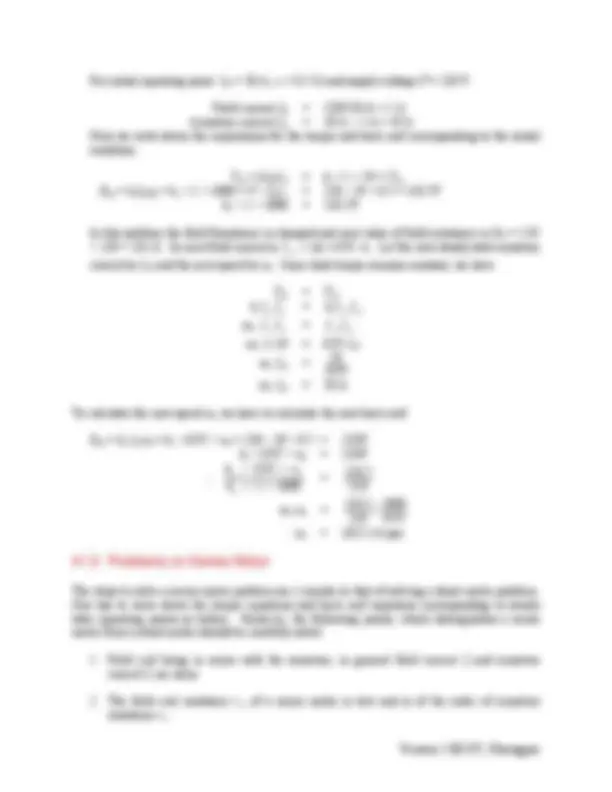
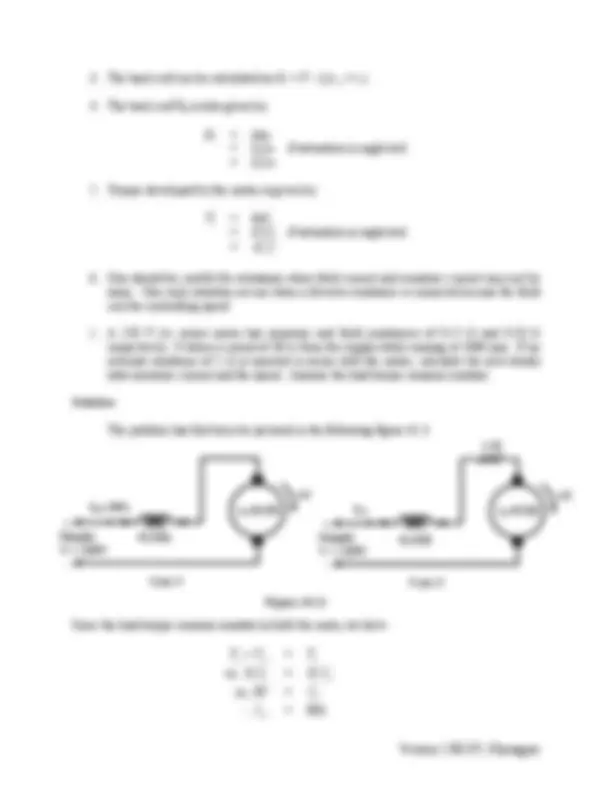
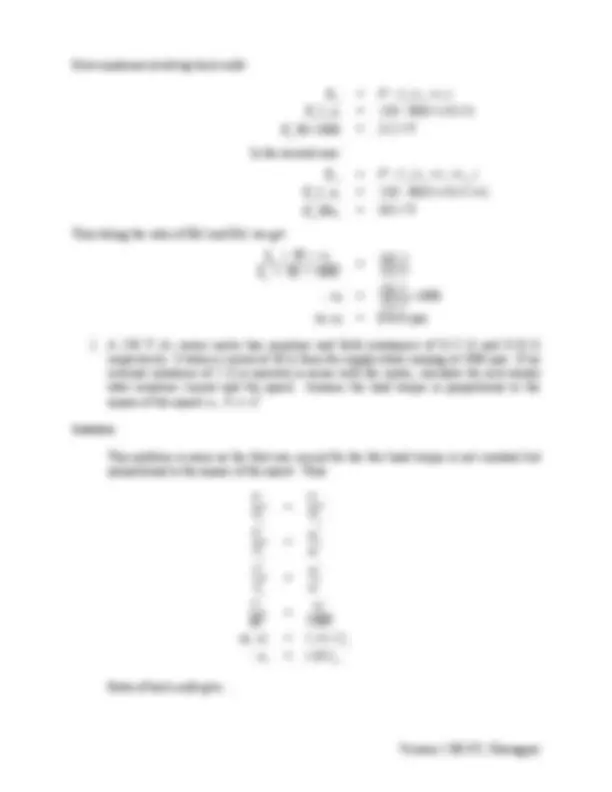
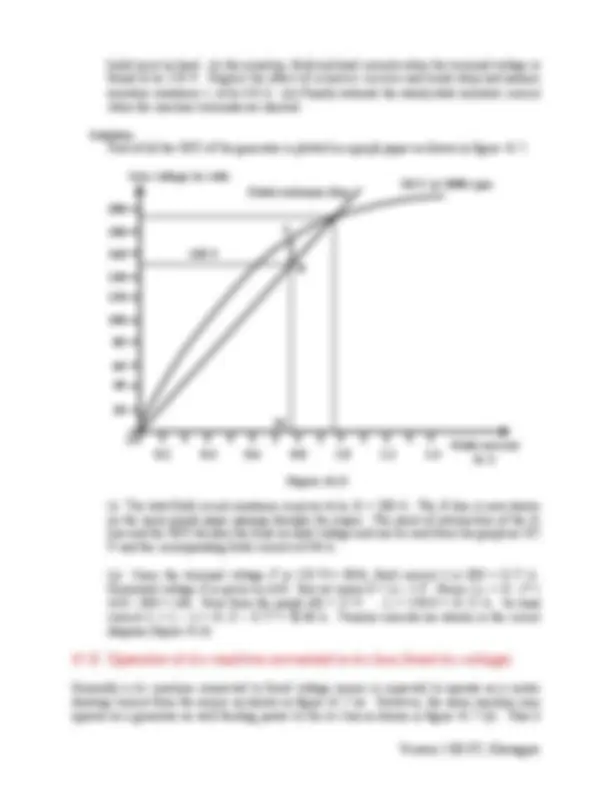
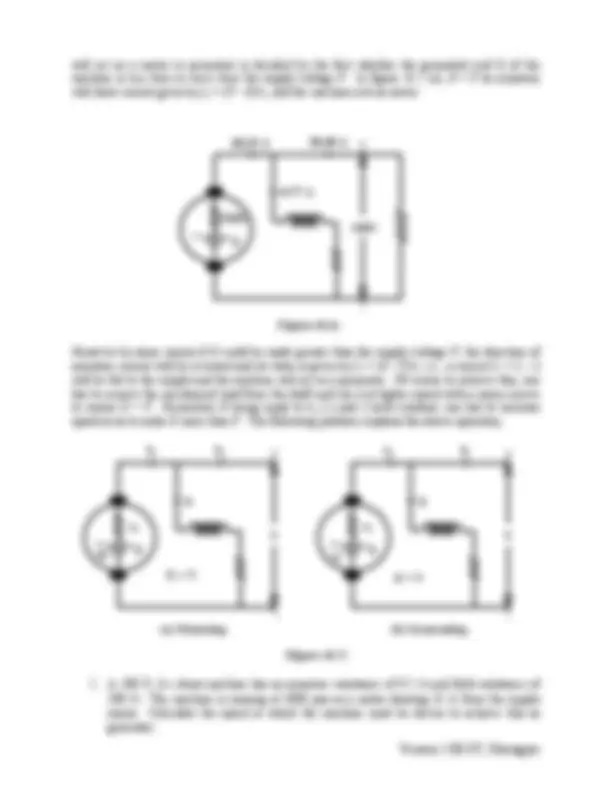
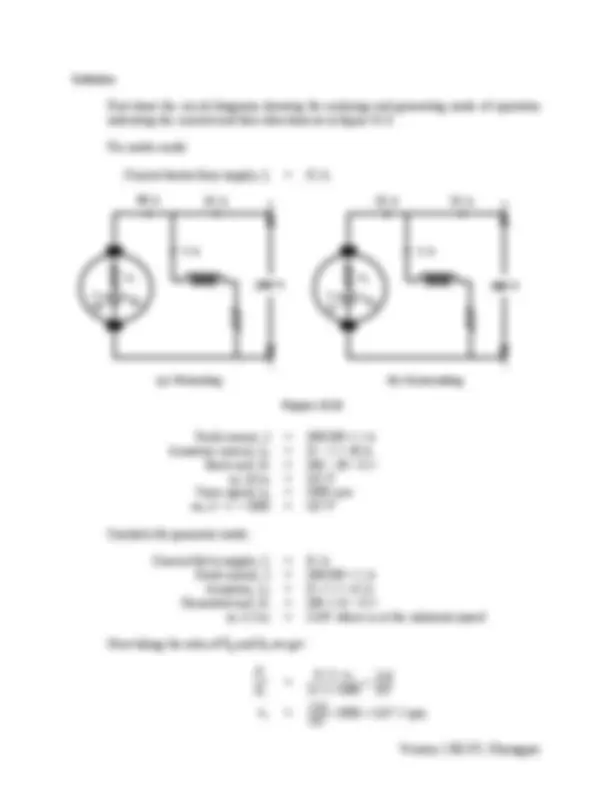


Study with the several resources on Docsity

Earn points by helping other students or get them with a premium plan


Prepare for your exams
Study with the several resources on Docsity

Earn points to download
Earn points by helping other students or get them with a premium plan
Community
Ask the community for help and clear up your study doubts
Discover the best universities in your country according to Docsity users
Free resources
Download our free guides on studying techniques, anxiety management strategies, and thesis advice from Docsity tutors
Let us now solve some problems on shunt, separately excited and series motors. 41.2 Shunt motor problems. 1. A 220 V shunt motor has armature and field ...
Typology: Summaries
1 / 16

This page cannot be seen from the preview
Don't miss anything!










In this lecture some typical problems on D.C machines are worked out not only to solve the problems only but also to bring out important features of the motors involving its performance. To begin with few problems on d.c motors have been solved and then problems on generator are taken up. For a beginner, it is suggested to follow the following guidelines for successful completion of the problem.
Let us now solve some problems on shunt, separately excited and series motors.
Solution
The circuit diagram of the shunt motor is:
+
I (^) a I (^) L
For initial operating point: IL 1 = 10 A, ra = 0.2 Ω and supply voltage V = 220 V.
Field current If 1 = 220/220 A = 1A Armature current Ia 1 = 10A – 1A = 9A
Now we write down the expressions for the torque and back emf.
Te 1 = kt If 1 Ia 1 = kt × 1 × 9 = TL Eb 1 = kg If 1 n = kg × 1 × 1000 = V – Ia 1 ra = 220 – 9 × 0.2 = 218.2V kg × 1 × 1000 = 218.2V
Since field resistance remains unchanged If 2 = If 1 = 1 A. Let the new steady armature current be Ia 2 and the new speed be n 2. In this new condition the torque and back emf equations are
Te 2 = kt ×1 × Ia 2 = TL Eb 2 = kg × 1 × n 2 = V – Ia 2 ( ra + Rext ) ∴ kg × 1 × n 2 = 220 – Ia 2 × 5.2 V
Taking the ratios of Te 2 and Te 1 we get,
2 1
e e
t t
k I k
× × a × × Thus, Ia 2 = 9 A
Now taking the ratio emfs EE^ bb^21 , we get,
(^12) 1 1000
g g
k n k
− I a ×
n rps^ -
V (supply)
I (^) f
Figure 41.1: D.C shunt motor.
M Te V (supply)
r (^) a
I (^) a I (^) L (^) +
I (^) f
Eb
Rf
22 10002
n (^) = 2 9
I a
2 9
I (^) a = 22 10002
n
or, 1000^ n^2^ = I 3^ a^2
Taking the ratios of Eb 2 and Eb 1 we get,
(^12) 1 1000
g g
k n k
− I a ×
2 1000
n (^) = 220 2 5.
− I a ×
substitution gives: 3 I^ a^2 = (^220) 218.2−^ I^ a^2 ×5.
simplification results into the following quadratic equation:
0.005 I (^) a^2 2 − 1.43 I (^) a 2 +9.15 = 0 Solving and neglecting the unrealistic value, Ia 2 = 7 A ∴ n 2 = I 3^ a^2 ×1000 rpm
= 37 ×1000 rpm thus, n 2 = 881.9 rpm
Solution
As usual let us begin the solution by drawing the shunt motor diagram.
n rps^ -
V (supply)
I (^) a
I (^) f
Figure 41.2: D.C shunt motor.
M Te V (supply)
r (^) a
I (^) a I (^) L (^) +
I (^) f
Eb
Rf
For initial operating point: IL 1 = 20 A, ra = 0.5 Ω and supply voltage V = 220 V.
Field current If 1 = 220/220 A = 1 A Armature current Ia 1 = 20 A – 1 A = 19 A Now we write down the expressions for the torque and back emf corresponding to the initial condition.
Te 1 = ktIf 1 Ia 2 = kt × 1 × 19 = TL 1 Eb 1 = kgIf 1 n 1 = kg × 1 × 1000 = V – Ia 1 ra = 220 – 19 × 0.5 = 210.5V kg × 1 × 1000 = 210.5V
In this problem the field Resistance is changed and new value of field resistance is Rf 2 = 1. × 220 = 231 Ω. So new field current is I (^) f 2 = 220231 = 0.95A. Let the new steady state armature current be Ia 2 and the new speed be n 2. Since load torque remains constant, we have:
Te 1 = Te 2 k It f 1 I (^) a 1 =^ k It f 2 Ia 2 or, I (^) f 1 I (^) a 1 = I (^) f 2 Ia 2 or, 1× 19 = 0.95 Ia 2 or, Ia 2 = (^) 0.95^19 or, Ia 2 = 20 A
To calculate the new speed n 2 , we have to calculate the new back emf:
Eb 2 = kg If 2 n 2 = kg × 0.95 × n 2 = 220 – 20 × 0.5 = 210V kg × 0.95 × n 2 = 210V 0.95 2 1 1000
g g
k n k
or, n 2 = 210.5 210 ×^1000 0. ∴ n 2 = 1055.14 rpm
The steps to solve a series motor problem are δ similar to that of solving a shunt motor problem. One has to write down the torque equations and back emf equations corresponding to steady state operating points as before. However, the following points, which distinguishes a series motor from a shunt motor should be carefully noted.
Now equations involving back emfs:
Eb (^) 1 = V − I (^) a 1 ( rse + ra ) K (^) g I (^) a 1 n 1 = 220 − 30(0.1 +0.15) K (^) g 30 × 1000 =^ 212.5 V In the second case: Eb (^) 2 = V − I (^) a 2 ( rse + ra + rext ) K (^) g I (^) a 2 n 2 = 220 − 30(0.1 + 0.15 +1) K (^) g 30 n 2 =^ 182.5 V
Thus taking the ratio of Eb2 and Eb1 we get:
(^302) 30 1000
g g
k n k
∴ n 2 = 182.5212.5^ × 1000 or, n 2 = 858.8 rpm
Solution
This problem is same as the first one except for the fact load torque is not constant but proportional to the square of the speed. Thus:
2 1
e e
2 1
L L
2 1
e e
22 12
n n (^22) (^21)
a a
22 12
n n (^22) 302
I (^) a = 22 1000
n
or, n 2^2 = 1.11 × Ia^22 ∴ n 2 = 1.05 Ia 2
Ratio of back emfs give:
2 1
b b
− I a ×
2 2 1 1
g a g a
K I n K I n =^
− I a ×
2 2 (^301)
g a g
K I n K × × n =^
− I a ×
I (^) a I (^) a = 220 2 1.
− I a ×
1.05 I (^) a^22 = 141.18(220 − Ia 2 ×1.25)
1.05 I (^) a^2 2 + 176.48 Ia 2 − 31059.6 = 0 Solving we get, Ia 2 ≈ 107.38 A Hence speed, n 2 = 1.05 × Ia 2 = 1.05 × 107. or, n 2 = 112.75 rpm.
Next let us solve a problem when a diverter resistance is connected across the field coil.
Solution
Following figure 41.4 shows the 2 cases in which the motor operate.
In the second case it may be noted that If 2 ≠ Ia 2. In fact, If 2 is a fraction of Ia 2. Since the field coil and diverter are connected in parallel we have:
If 2 =^ f a 2 f d
r (^) a=0.15 Ω
n I (^) a1=30A
Supply V = 220V
Case 1
r (^) a=0.15 Ω
n I (^) a
Supply V = 220V
Case 2
I (^) f
Figure 41.4:
build up at no load. (ii) the armature, field and load currents when the terminal voltage is found to be 150 V. Neglect the effect of armature reaction and brush drop and assume armature resistance ra to be 0.8 Ω. (iii) Finally estimate the steady state armature current when the machine terminals are shorted.
Solution First of all the OCC of the generator is plotted in a graph paper as shown in figure 41.5.
(i) The total field circuit resistance is given to be Rf = 200 Ω. The Rf line is now drawn on the same graph paper passing through the origin. The point of intersection of the Rf line and the OCC decides the final no load voltage and can be read from the graph as 192 V and the corresponding field current is 0.96 A.
(ii) Since the terminal voltage V is 150 V(= BM), field current If is OM = 0.77 A. Generated voltage E is given by AM. But we know E = Iara + V. Hence Iara = E – V = AM – BM = AB. Now from the graph AB = 25 V. ∴ Ia = 25/0.8 = 31.25 A. So load current IL = Ia – If = 31.25 – 0.77 = 30.48 A. Various currents are shown in the circuit diagram (figure 41.6).
Generally a d.c machine connected to fixed voltage source is expected to operate as a motor drawing current from the source as shown in figure 41.7 (a). However, the same machine may operate as a generator as well feeding power to the d.c bus as shown in figure 41.7 (b). That it
Field current in A
Field resistance line
Figure 41.5:
Gen voltage in volts OCC at 1000 rpm
will act as a motor or generator is decided by the fact whether the generated emf E of the machine is less than or more than the supply voltage V. In figure 41.7 (a), E < V so armature will draw current given by Ia = ( V – E )/ ra and the machine acts as motor.
Figure 41.6:
However by some means if E could be made greater than the supply voltage V , the direction of armature current will be reversed and its value is given by Ia = ( E – V )/ ra i.e., a current IL = Ia – If will be fed to the supply and the machine will act as a generator. Of course to achieve this, one has to remove the mechanical load from the shaft and run it at higher speed with a prime mover to ensure E > V. Remember E being equal to kg If n and If held constant, one has to increase speed so as to make E more than V. The following problem explains the above operation,
I (^) a I (^) L + I (^) a I (^) L +
r (^) a V
I (^) f
(a) Motoring
r (^) a
I (^) f
(b) Generating
Figure 41.7: